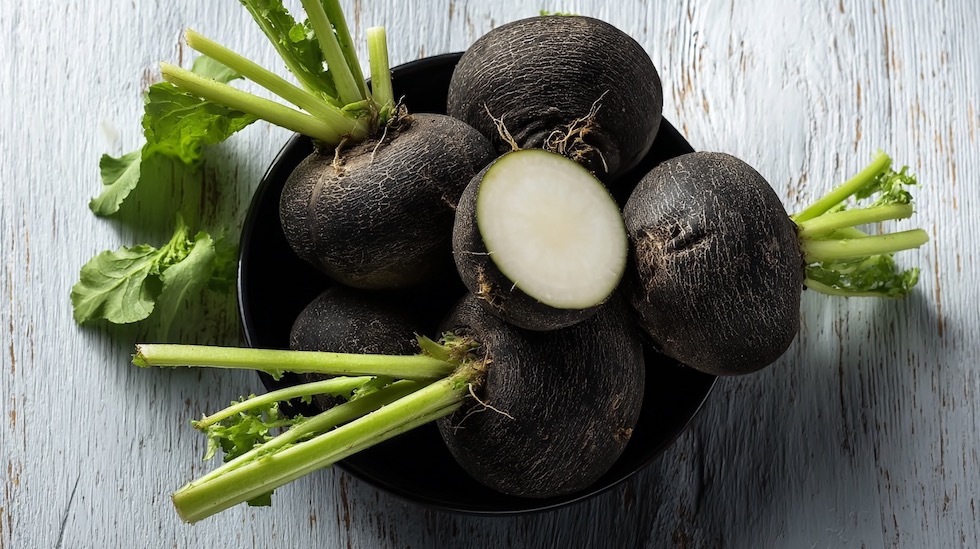Black radish – a tangy, characterful and healthy friend in winter
If you’ve only known the reddish month radish, it’s time to get to know its big brother – the black radish! This dark-skinned, snow-white fleshed vegetable is a true winter vitamin bomb that not only supports your health, but also has a surprisingly versatile use in your kitchen.

The black radish (Latin Raphanus sativus var. niger ) belongs to the cabbage family, as does broccoli or kale. In Hungarian it is often simply called ‘winter radish’, which is not surprising as it is the vegetable queen of the cold months. Its native habitat is probably the Middle East, but it was cultivated by the ancient Egyptians and even given to pyramid-building workers, who believed it to be a source of strength. 💪
How important is it in the kitchen?
Importance: 3/5
Although not one of the most commonly used vegetables, black radish deserves a place in your kitchen for its special taste and medicinal properties. It is especially important in winter, when the choice of fresh vegetables is more scarce – it is one of the best choices.
What can you eat from it?
The edible part of the black radish is the root itself – the part that grows underground. This is the part that has a dark brown or blackish skin and is white, crunchy and tangy inside. The fresh, tender leaves can also be eaten, for example in salads or cooked into soups, but these are rarely sold. Other parts of the plant (e.g. flowers, stems) are not commonly eaten and have no particular culinary role.
Health benefits – strength in hips
This root vegetable is full of valuable substances:
- high in vitamin C, which helps the immune system,
- contains glucosinolates and sulphur compounds, which have natural antibacterial properties,
- aids digestion and the production of bile,
- has a hepatoprotective effect and is therefore also used as a folk remedy for liver complaints,
- rich in fibre, which helps intestinal function and detoxification.
It can also be used as a natural cough syrup when mixed with honey for colds – even grandmothers knew that! 🍯
Where does it grow, when is it available?
Black radishes are a true autumn-winter vegetable. It is grown in the open air, typically sown in late summer and harvested in autumn. The largest producing countries in Europe are Germany, Poland and Hungary. In Hungary it is mainly grown in the lowlands.
You can find domestic black radishes in the shops from October to February. In spring, if they are still available, they are usually imported – mainly from Poland or Germany. They are not grown in glasshouses because they can withstand the cold.
How to choose the right one?
It’s not complicated, but there are a few tricks:
- Make it hard to the touch – a soft one will have lost its moisture.
- There should be no cracks, damage or mould stains.
- Avoid extremely large pieces, as they can be hollow inside.
- The skin can be rough to the touch, which is natural – but it should not be slimy or sticky.
Storage tips – cool, dry
Black radish stays fresh if:
- you do not wash it after purchase, only immediately before consumption,
- store in the vegetable drawer of your fridge, where it will keep for 1-2 weeks,
- can be stored in a cool chamber or cellar for larger quantities – thrives in sand or paper bags!
How it is used in the world
Not only popular in our country! It is also grown in France, where it is often eaten with butter and salt as a sandwich. Germans also like it pickled. In India and the Middle East, it is also used cooked and added to curries – although white or purple varieties are preferred. It is also known worldwide for its liver cleansing properties.
Classic recipe: black radish syrup with honey
Ingredients:
- 1 medium black radish
- 2-3 tablespoons honey
Cut a small “hat” off the top of the radish, cut out the centre and fill with honey. Let stand for a few hours, then spoon out the sweet, tangy juice. A great natural expectorant, recommended by grandmothers for colds.
Tips for use in the kitchen
Black radish has a pungent, distinctive flavour – but that’s what’s so exciting! Some tips:
- Grated, it is excellent in salads, especially when mixed with a little lemon juice or yoghurt.
- If it’s too strong, salt it and let it stand for 10 minutes – this will reduce the strength.
- Mix it with cream or butter to make a heavenly sandwich cream.
- Thinly sliced with olive oil and fresh herbs, it makes a delicious starter.
What spices go with it?
- Works well: salt, pepper, lemon juice, cumin, garlic, parsley
- Avoid: sweet spices (e.g. cinnamon, cloves) as they do not harmonise with the strong, spicy flavours.
To sum up: black radish is a slightly underrated but very useful and healthy vegetable that you should take a closer look at – especially if you like exciting flavours and natural remedies! 🖤
